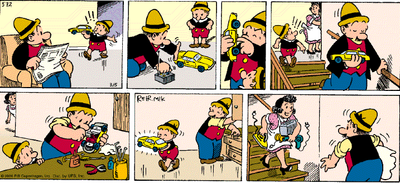
Ferd'nand
Encyclopedia

Comic strip
A comic strip is a sequence of drawings arranged in interrelated panels to display brief humor or form a narrative, often serialized, with text in balloons and captions....
notable for its lack of word balloons
Speech balloon
Speech balloons are a graphic convention used most commonly in comic books, comic strips and cartoons to allow words to be understood as representing the speech or thoughts of a given character in the comic...
and captions, lack of continuity
Continuity (fiction)
In fiction, continuity is consistency of the characteristics of persons, plot, objects, places and events seen by the reader or viewer over some period of time...
and its longevity (over seven decades).
Background
Ferd'nand was first published in 1937 by the Presse-Illustrations-Bureau of CopenhagenCopenhagen
Copenhagen is the capital and largest city of Denmark, with an urban population of 1,199,224 and a metropolitan population of 1,930,260 . With the completion of the transnational Øresund Bridge in 2000, Copenhagen has become the centre of the increasingly integrating Øresund Region...
. Created by Henning Dahl Mikkelsen
Henning Dahl Mikkelsen
Henning Dahl Mikkelsen was a Danish cartoonist, best known for creation of the long running newspaper comic strip Ferd'nand, which he signed as Mik....
, Ferd'nand features the adventures of the title character, his unnamed wife, unnamed son and family dog. Like Otto Soglow
Otto Soglow
Otto Soglow was an American cartoonist best known for his comic strip The Little King.Born in Yorkville, Manhattan, Soglow grew up in New York City, where he held various jobs as a teenager and made an unsuccessful effort to become an actor. His first job was painting designs on baby rattles...
's The Little King
The Little King
The Little King was a comic strip created by Otto Soglow, famously telling its stories in a style using images and very few words, as in pantomime.-Publication history:...
, there is no dialogue in the strip. The characters only speak via the occasional set of exclamation points or question marks. This enabled the strip to achieve a wide distribution throughout Europe and, starting November 10, 1947, in the United States. At present, the strip is said to appear in 100 different newspapers in 30 countries.
Author
Mikkelsen, or "Mik" as he preferred to be known, moved to the United States in 1946, becoming a citizen in 1954. Mikkelsen turned over the strip to others, including Frank ThomasFrank Thomas (comics)
Frank Thomas was a Golden Age American cartoonist who worked primarily for Centaur Publications.For Centaur he created The Eye, Chuck Hardy, Dr. Hypno, and Solarman . Later in his career, he worked for Dell on The Owl, Billy and Bonnie Bee, Buddies and other characters...
(no relation to Disney's Frank Thomas
Frank Thomas (animator)
Franklin M. "Frank" Thomas was an American animator. He was one of Walt Disney's team of animators known as the Nine Old Men....
) for a time from 1955 until the mid-1960s. He then drew it until his death in 1982, after which Al Plastino
Al Plastino
Al Plastino is an American comic book artist best known as one of the most prolific Superman artists of the 1950s, along with his DC Comics colleague Wayne Boring...
, drew it until 1989. Plastino's strips were signed "Al + Mik".
Henrik Rehr, a Danish illustrator and painter and current author, took over the strip in 1989. Rehr's strips are signed "Rehr.Mik".
Characters and story
The main character, presumably named Ferd'nand, is a round, mustachioedMoustache
A moustache is facial hair grown on the outer surface of the upper lip. It may or may not be accompanied by a type of beard, a facial hair style grown and cropped to cover most of the lower half of the face.-Etymology:...
, middle-aged father and husband, recognized by his conical hat. Ferd'nand's son also sports a similar hat, while his wife and dog (named Fido) are rather unremarkable in appearance. Ferd'nand's father also appeared in one strip looking and being dressed like his son, except for the white hair and moustache and wearing eye glasses.
Unlike most strips, Ferd'nand lacks basic continuity or any cast of recurring characters other than the immediate Ferd'nand family. Ferd'nand himself has been seen working in nearly every occupation and in any location imaginable. Similarly, each strip stands alone - no story spans multiple strips. This lends a rather fantasy-like, ephemeral air to the strip.
Films
Only two Ferd'nand animated cartoons were produced, both directed by H. Dahl Mikkelsen:- Ferd'nand på fisketur (Ferd'nand's fishing trip) (1944)
- Ferd'nand på bjørnejagt (Ferd'nand's bear hunting) (1945)

